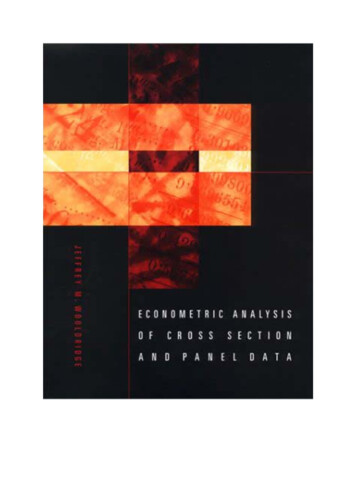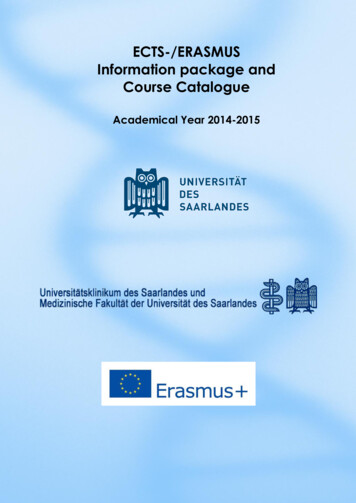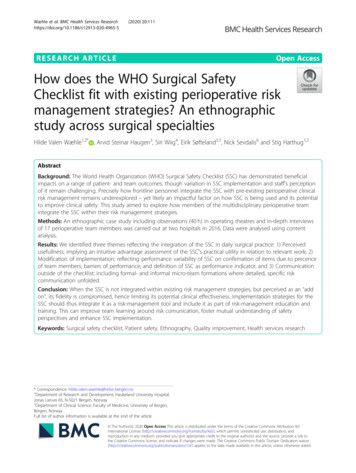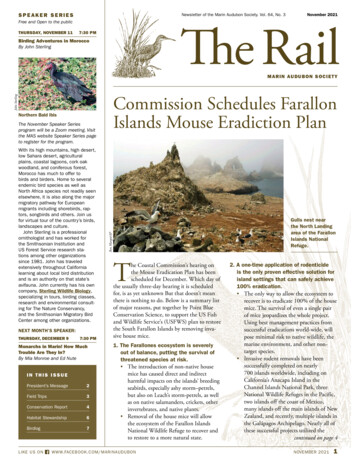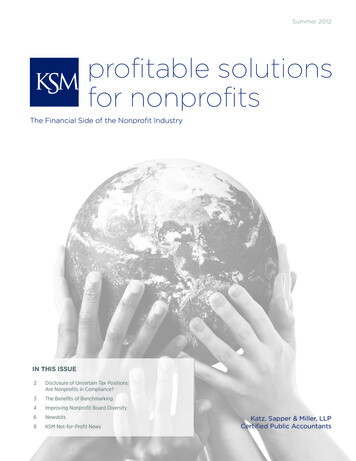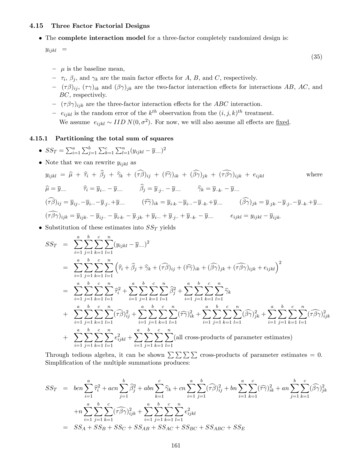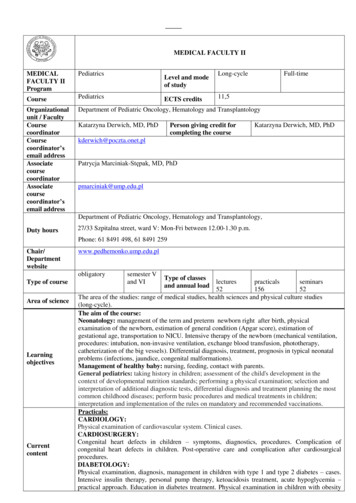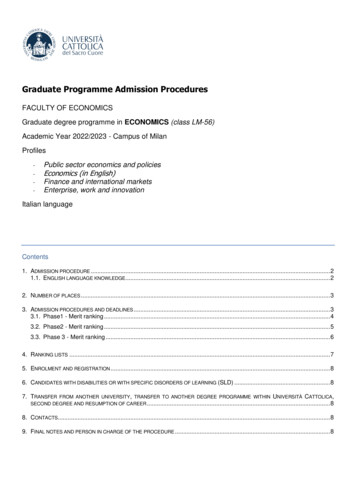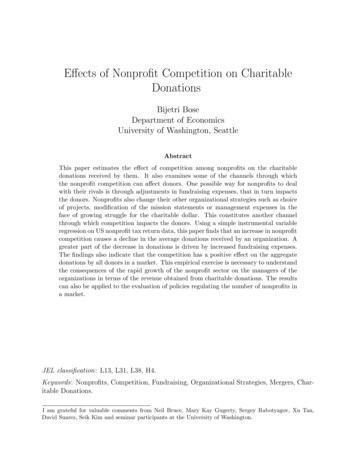
Transcription
Effects of Nonprofit Competition on CharitableDonationsBijetri BoseDepartment of EconomicsUniversity of Washington, SeattleAbstractThis paper estimates the effect of competition among nonprofits on the charitabledonations received by them. It also examines some of the channels through whichthe nonprofit competition can affect donors. One possible way for nonprofits to dealwith their rivals is through adjustments in fundraising expenses, that in turn impactsthe donors. Nonprofits also change their other organizational strategies such as choiceof projects, modification of the mission statements or management expenses in theface of growing struggle for the charitable dollar. This constitutes another channelthrough which competition impacts the donors. Using a simple instrumental variableregression on US nonprofit tax return data, this paper finds that an increase in nonprofitcompetition causes a decline in the average donations received by an organization. Agreater part of the decrease in donations is driven by increased fundraising expenses.The findings also indicate that the competition has a positive effect on the aggregatedonations by all donors in a market. This empirical exercise is necessary to understandthe consequences of the rapid growth of the nonprofit sector on the managers of theorganizations in terms of the revenue obtained from charitable donations. The resultscan also be applied to the evaluation of policies regulating the number of nonprofits ina market.JEL classification: L13, L31, L38, H4.Keywords: Nonprofits, Competition, Fundraising, Organizational Strategies, Mergers, Charitable Donations.I am grateful for valuable comments from Neil Bruce, Mary Kay Gugerty, Sergey Rabotyagov, Xu Tan,David Suarez, Seik Kim and seminar participants at the University of Washington.
1IntroductionThe nonprofit sector in USA has been growing steadily in size for more than a decade.Between 2000 and 2010, the number of all registered nonprofits has increased by 24 percent.In 2010, nearly 1.6 million nonprofits, not including religion congregations and smaller organizations, were registered with the Internal Revenue Service (IRS). The rapid growth ofnonprofits is considered beneficial due to the greater provision of good and services by thecharitable organizations, supplementing the efforts of the government. However, the increasing number of nonprofits also increases the competition for limited resources among them.This paper studies the effect of competition among nonprofits on a particular resource —thecharitable donations from individual donors and foundations.Many nonprofits are reliant on private contributions as a major source of revenue. In2010, private charitable donations to public charities and religious organizations totaled 286.91 billion, accounting for about 24 percent of the total revenue of reporting publiccharities, after excluding organizations that derive their funding mainly through fees forgoods and services from private sources.1 The focus of this paper is on donative nonprofitswhich predominantly depend on donative support from private sources to provide pure publicgoods, distributional public goods or private goods with some external benefits. Charitabledonations, dependent on the economic realities, has not grown at the same pace as thenumber of charitable organizations during the past decade, making competition for thecharitable dollar a pressing issue for the nonprofit sector.A growing literature investigates why a representative donor gives to nonprofit organizations and how these organizations behave, without paying attention to the interaction ofthe agents in the market structure.2 The few papers that do attempt to empirically estimatethe effects of nonprofit competition concentrate on changes in specific nonprofit strategies.In reality, donors are subject to an entire gamut of strategies that a nonprofit can adjustto gain comparative advantage over its rivals. The primary contribution of this paper is toestimate the effect of nonprofit competition on donors in terms of charitable donations. Furthermore, the total effect of competition is decomposed into a direct effect and an indirecteffect, in order to analyze two different channels through which nonprofit competition can1Registered organizations exclude nonprofits with less than 5,000 in annual revenue or religious congregations, although many congregations choose to register. This encompasses a variety of organizationsincluding health, education, arts, advocacy organizations, labor unions, and business and professional associations. Reporting organizations are nonprofits with gross receipts of 25,000 or more that are required tofile a Form 990 or Form 990-EZ with the IRS (before 2010). Public charities are 501(c)(3) arts, education,health care, human services, and other types of organizations to which donors can make tax-deductibledonations. These are what we refer to as nonprofits in layman terms.2See Andreoni (2006), Vesterlund (2006).1
affect charitable donations.One of the impacts of nonprofit competition is on their fundraising expenses. Fundraisingexpenses are those expenses that nonprofits spend to raise money and can include any costincurred in soliciting donations, memberships and grants. Existing papers have examinedhow competition for funds affects fundraising by nonprofits, though, with contradictoryevidence (Feigenbaum, 1987; Thornton, 2006; Castaneda et al., 2008). Since fundraisingefforts by the nonprofits influence the amount of donations received by them, there is anindirect effect of competition on charitable donations (Weisbrod Dominguez, 1986; PosnettSandler, 1989; Okten Weisbrod, 1998; Khanna, Posnett Sandler, 1995; Khanna Sandler,2000).In addition to fundraising, there are many other strategies that nonprofit organizationscan adopt in the face of rising competition for donations, such as changes in mission statements or expenses on staff perquisites and administrative costs, emphasis on innovation andchoice of product and service mix. When a donor learns about the changes in these variousaspects of nonprofit behavior due to competition, they adjust their charitable contributionsto reflect their preferences. This is referred to as the direct effect of competition on givingby donors.3 The distinction between the direct and indirect channels through which nonprofit competition operates arises from the increasing attention on fundraising by nonprofitmanagers and scholars. More importantly, fundraising expenses of nonprofits has positiveand negative effects on donors, creating ambiguity about its net effect.The hypotheses underlying the paper is based on a model of monopolistic competitionamong horizontally differentiated nonprofits to incorporate a wide range of nonprofit behaviorthat competition influences. Since a decline (increase) in the total contributions by alldonors in a market does not necessarily imply lower (higher) donation receipt for individualnonprofits, the estimation exercise is carried out at the average nonprofit level as well as theaggregate level of donations. The annual tax return data of US public charities from 19982003 is used to empirically examine the effect of the competition on charitable donations.The instrumental variables method is used to estimate the effects of market competition byovercoming identification issues. This paper is the first study to instrument the index ofnonprofit competition to reduce bias caused by endogeneity of market competition.The key findings of this paper is that average donations received by a nonprofit in amarket decreases, both directly and indirectly, due to greater nonprofit competition. Thereduction in average receipt of charitable donations by a nonprofit is driven by the indirect3Direct effect is so called because its estimate might include some of the reaction of donors to competition,irrespective of nonprofit strategies. The term is used to distinguish between the effect of nonprofit competitionon donations with and without fundraising intervention.2
effect of competition operating through augmented fundraising expense of the organization.Fundraising is the predominant strategy used by nonprofits when confronted with many rivals, accounting for more than half of the change in charitable donations. At the market levelthe direct and indirect effects are positive, with the total effect of competition on the aggregate charitable donations being favorable. This suggests that while competition encouragessome to contribute more, most donors might simply be switching their contributions fromone nonprofit to another in response to the changes in their organizational strategies.The motivation behind this paper is to understand the implications of increasing nonprofitcompetition for policy makers and managers. First, the results of this paper is helpful indetermining whether there is need to control the growth of nonprofits. They are also appliedto evaluate policies that lead to regulation of competition among nonprofits. An exampleis the increased monitoring of nonprofits by the Internal Revenue Service (IRS) followingthe new tax return filing requirements of the Pension Protection Act of 2006. Second, theinvestigation of the direct and the indirect effects of competition can also assist nonprofitmanagers in deciding their action plan when pitted against each other. One possible action ismergers among nonprofits. The effect of mergers on charitable donations is examined basedon the findings of this paper, a necessary analysis in the absence of merger guidelines fornonprofits.The structure for the remainder of the paper is as follows. The next section providesa background discussion of nonprofit competition. Section 3 describes the data and theestimation methodology. Section 4 presents the empirical results. Section 5 discusses thefindings with special attention to nonprofit policy and managerial implications. Section 6concludes.2The Nonprofit Firm & the MarketEconomic theories analyze competition among nonprofits for charitable donations from anindustrial organization perspective. The nonprofit market is characterized by monopolisticcompetition, where many organizations supply similar but differentiated goods and services.There is an inherent propensity for donative nonprofit organizations to specialize (BilodeauSlivinski, 1998). For example, educational institutions differ in the type of the education theyprovide and their target population. Following Rose-Ackerman, who was the first to discussthe market structure of nonprofits in her model of fundraising, nonprofits are considered tobe differentiated along one dimension —ideology.Donors give to nonprofits because of the benefits from the output, the warm-glow theyreceive, out of self-interest or altruistic concerns about the society (Andreoni, 2006). Regard3
less of the reasons for giving, utility of donors is an increasing function of their amount ofcharitable contribution. The donors choice of nonprofit becomes relevant when the horizontally differentiated nature of nonprofit markets is incorporated into the utility maximizationmodel. While giving, donors decide how much to donate as well as which nonprofit to support. With the existence of several nonprofits producing similar goods and services, donorspreferences over the organizations ideologies, shares of their revenue devoted to output,perquisite expenses, use of innovative technologies and other behavioral aspects of the nonprofit organizations start to matter. The amount of donation a donor makes to a specificnonprofit reflects their preferences on all or some of these aspects. Given this structure of themodel, if increasing competition causes the nonprofits to adjust one or more of these facetsof their behavior, then there will be changes in the giving by donors too. Donors can adjustthe amount of their charitable donations or change the nonprofit organizations supported bythe donors.Many papers theoretically predict how change in the number of competing nonprofits ina market will affect the different aspects of nonprofit behavior. One such strategic decisionaffected by the nonprofit competition for scarce donor resources is fundraising. Fundraising,a vibrant, innovative and highly professional industry (Andreoni, 1998), is important becauseit influences charitable donations received by nonprofits. Therefore, any effect of nonprofitcompetition on fundraising will be reflected on the donations of the donors. This is referredto as the indirect effect of nonprofit competition on charitable donations. The direction ofthe indirect effect of competition is governed by two factors.First, is the relationship between nonprofit competition and fundraising expenses. RoseAckerman (1982) discusses how competition for donations can lead to excessive fundraisingby nonprofits even when donors care about fundraising expenses. Castaneda et al.(2008)theoretically prove that an exogenous increase in nonprofit competition increases fundraisingexpenditures. While Rose-Ackerman recognizes that donors have some preferred ideologyand tend to donate to nonprofits that match their preferences, neither paper gives value tothe fact that entry of nonprofits in a market increases the welfare of donors by reducingthe average distance between the closest nonprofit and donors’ preferred ideology. Aldashevand Verdier (2010) address the shortcoming in a model that demonstrates how the effect ofnonprofit competition on fundraising depends on the type of donors in the market. If thenumber of donors in a market is fixed, the only way a nonprofit can increase its donations isby convincing the individuals of its relative importance, thereby escalating the fundraisingexpenses of the organization. On the other hand, with a variable size of the donor market,fundraising can awaken potential donors to give. In this scenario, if there are too many rivals,the expected return from each dollar spent in fundraising declines. A rational nonprofit ends4
up not spending much on soliciting donors. Thus, the effect of nonprofit competition onfundriaisng expenses is positive or negative depending on the nature of the donor market.There is some empirical evidence that complement the above theories on the relationshipbetween nonprofit competition for donations and fundraising. The first study by Feigenbaum(1987) examines competition among medical research charities for donations and finds thatorganizations spend more on fundraising expenses under intense competition. Thornton(2006) builds on the work of Feigenbaum (1987) by studying a broader set of nonprofits.Unlike the previous study, he finds a negative relationship between fundraising expensesand nonprofit competition. Castaneda et al. (2008) support their theoretical predictionsby showing that greater nonprofit competition increases the fraction of donations allocatedto fundraising. Therefore, there is a significant effect of competition among nonprofits ontheir fundraising expenses but a lack of consensus in the literature about the direction of theeffect.Second, is the effect fundraising by nonprofits has on donors. It positively affects donations by influencing donor preferences, reducing the search cost of donors and signalingthe quality of nonprofits (Bilodeau Steinberg, 2006). On the contrary, solicitation divertsfunds away from the final product, generating a negative price effect on giving by donors.The overall impact of fundraising on charitable donations depends on the magnitudes of thetwo opposing forces. There are many papers that have estimated the donation productionfunction, which states the relationship between fundraising expenses of a nonprofit and charitable donations received by it, depending on other characteristics of the organization anddonors. These studies confirm the significant effect of fundraising on donations (WeisbrodDominguez, 1986; Posnett Sandler, 1989; Okten Weisbrod, 1998; Khanna, Posnett Sandler, 1995; Khanna Sandler, 2000) but the empirical findings of this strand of literaturehave been divergent. It, therefore, is necessary to consider how the two factors that affectthe indirect effect of competition interact to predict if it is positive or negative.Fundraising is not the only choice variable available to nonprofits to battle competition.As mentioned above, there are additional strategies that nonprofits resort to when faced withincreasing competition such as choice of the next project, adoption of newer technology, modification of mission statements. Insofar as one or more of these variables of nonprofits areaffected by changes in the degree of competition in the donation market, the charitablecontributions will change accordingly if donors care about these variables. There are twopapers (Economides and Rose-Ackerman, 1993; Pestieau and Sato, 2006) that theoreticallyprove the effect of nonprofit competition on the locational and quality of output choices ofnonprofits. Instead of focusing on each of these strategies individually, it will be more informative to examine the effect of competition on donors because of the possible simultaneous5
changes in these factors.The effect of nonprofit competition on charitable donations working separate from fundraising intervention is the direct effect. Direct effect of competition, as defined in this paper,encompasses changes in multiple behavioral aspects of nonprofits that affects donors. Theincrease in competition for donations acts to check massive rent extraction and to keep nonprofits oriented towards customers (Glaeser, 2003). With intense rivalry for limited donations, nonprofits will implement various tactics that appeal to donors, unlike a monopolisticnonprofit with the inclination to slack off. Competition in a market will induce organizations to enhance efficiency by reducing managerial or perquisite expenses, wiser selection ofprojects, improve quality of production and encourage innovation, leading to greater contributions by donors. This is in line with the findings of Feigenbaum (1987) and Castaneda etal. (2008) that increasing competition increases the share of donations devoted to outputand decreases in perquisite consumption, assuming all other aspects of the organizationsbehavior as exogenous. The issue that remains unresolved is how all these variations inthe different nonprofit strategies, stemming from competition, together impact charitabledonations.It is important to note that the existence of the direct effect of competition is based onan assumption about the exchange of information between donors and nonprofits. It is oftenmistakenly believed that fundraising is the sole means through which information passesfrom nonprofits to donors. However, there is recent heightened interest in the other sourcesthrough which it is possible for donors to obtain information about nonprofits. Mandatorypublic disclosure of annual returns of nonprofits, third-party charity ratings (ChhaochhariaGhosh, 2008; Grant, 2010; Yoruk, 2014) and flow of information through social networks(Shang Croson, 2009) enable donors to learn about different nonprofits, evaluate them anddecide on whom to donate to and how much to contribute. Recent research shows thatdonors increasingly rely on public financial information as a tool to guide donation decisionsby distinguishing relative efficiency among competing firms (Lammers, 2003). Donors areno longer completely reliant on nonprofits to awaken them into giving. Access to the detailsof a nonprofit on the internet, a news report about the importance of Charity Navigator toasses nonprofits or a simple tweet about a new nonprofit in the block are examples in whichdonors can learn about nonprofits. The presence of external sources of information allowsconstant scrutiny by donors of all nonprofit characteristics. This enables donors to directlyrespond to adjustments in nonprofit behavior due to competition, even in the absence offundraising.Based on these considerations, the two hypotheses of this paper is that the direct effectof nonprofit competition on charitable donations is positive whereas the indirect effect is6
positive or negative depending on the nature of the donor market and net effect of fundraising on donations. The third hypothesis is that there is a difference in the average donationsat the nonprofit level and the aggregate donations at the market level. The mechanismsunderlying the direct and indirect effects of competition talk about donors response in termsof the amount of their donations. At the same time, donors can also respond to adjustmentsin nonprofit behavior due to varying degrees of competition by simply choosing to supporta different organization. In this event, the average donations received by nonprofits neednot change in the same direction as the aggregate donations. The average donations pernonprofit will increase, decrease or remain unaltered, depending on the extent of change intotal donations compared to number of nonprofits claiming a share of the total contribution. For instance, if donors respond to growing nonprofit competition by increasing theirdonations marginally or if they merely switch their funds to better performing nonprofits,the average donations will decrease despite an increase in the total donations collected atthe market level. If such is the case, estimates of aggreate donations will not prove usefulin informing individual nonprofits about how their revenues will be affected by competition.To avoid misleading inferences, I estimate the direct and indirect effects of competition atthe aggregate as well as the nonprofit level of donations.3An Empirical Model of Nonprofit CompetitionThis section discusses the compilation of the nonprofit data along with the choice ofvariables and their statistical properties. It then outlines the empirical strategy for estimatingthe direct and indirect effects of nonprofit competition on charitable donations.3.1Nonprofit DataThe data is obtained from the annual tax returns of US public charities from the period1998 to 2003. Public charities, those nonprofits with charitable, religious, educational, scientific, literary, environmental and other purposes are exempt from paying taxes under Section501(c)(3) of the Internal Revenue Code. A subset of public charities with revenue greaterthan 25,000 and non-faith-based organizations must annually file some version of the Form990 with the IRS. The forms have details on the nonprofits mission, programs, and finances.The National Center for Charitable Statistics (NCCS) at the Urban Institute collects the information from the forms and makes it available for researchers as convenient datasets. Thedata for this paper comes from the NCCS-GuideStar National Nonprofit Research Databasewhich contains observations on all nonprofits required to file the Form 990 and Form 990-EZ7
in the sample period. I augment the data with geographic level variables from the Bureauof Labor Statistics and Bureau of Economic Analysis.The nonprofit dataset is valuable for organization level analysis but is also erroneousin nature. The sample used for the empirical analysis is, therefore, systematically cleanedfollowing the methodology outlined in previous papers (Andreoni & Payne, 2003; Thornton &Belski, 2010; Heutel, 2013). Nonprofits with clear evidence of reporting errors are eliminated,reducing the sample by about 20 percent of the original size.4 Inability to calculate the validage of the nonprofits because of missing or faulty ruling year data leads to the nonprofitsbeing dropped from the study. The sample is restricted to nonprofits within a recognizablegeographic extent and discrepancies in the geographical identifiers of the remaining nonprofitsis corrected. Finally, I retain nonprofits with at least one year of positive donations andfundraising expenses in the sample. There are a few nonprofits that are established withsufficient financial backing or are entirely reliant on grants from the government or oneindividual, making it unnecessary for them to compete for charitable donations. Includingnonprofits with no receipt of donations and outlays on fundraising over the entire panel inthe sample will not inform the hypothesis and can lead to biased conclusions.3.2VariablesAn empirical analysis of competition must begin with the definition of a market. Sincenonprofits originate when there is market failure, traditional price based definitions of marketare rendered useless. While some studies in the nonprofit literature have used a productbased definition, others have specified nonprofit markets for charitable donations in terms ofgeographical areas.5 Casual observation of nonprofits suggests that a combination of the twoapproaches is better suited in characterizing the market for charitable donations. A marketin this paper includes all nonprofits supplying similar goods and services that are actual orpotential competitors within a well-defined area.I first define the relevant product market by identifying nonprofits that donors regardas substitutes. Since charitable contributions mirror the demand for the good or serviceprovided by the nonprofit, those producing similar outputs are considered substitutable.The National Taxonomy of Exempt Entities (NTEE) developed by the NCCS is used in thispaper to define the product market. The NTEE is a classification system that divides theuniverse of nonprofits into 26 major groups under 10 broad categories based on the kind of4These included: having donation or other sources of revenue exceed total revenue, or having fundraisingor other expenditures exceed total expenditures, reporting a negative value for private donations, governmentgrants, fundraising expenses, management expenses or program service revenue.5Twombly (2003); Harrison Laincz (2008); Nunnenkamp Ohler (2012).8
output provided. Based on the NTEE core codes, I club nonprofits providing substitutableservices into distinct sectors. For example, nonprofits working to protect individuals againstspousal abuse (I71), child abuse (I72) and sexual abuse (I73) are clustered under one sector—abuse prevention.Once the nonprofits are classified under various sectors, the geographic regions withinwhich they are considered substitutes by the donors are identified. I choose the MetropolitanStatistical Area (MSA) as the appropriate geographic unit for analysis. MSAs are defined toinclude local economic regions with populations of at least 100,000 and contain more thanone county.6 Continuing with the example of the abuse prevention, all nonprofits in thissector located within an MSA will constitute a market. This geographic dimension of themarket can be inappropriate in two cases. First, the MSA boundaries are overly narrow forlarge organizations like the UNICEF and the Red Cross that have national and internationalpresence. Second, easy transfer of funds anywhere in the world over the internet is now afact. These two factors can potentially result in misleading estimates of the effect of marketcompetition on donations. To lessen such bias, previous papers (Thornton, 2006; Castanedaet al., 2008) suggest restricting the nonprofit sectors to those that satisfy the following criteria:1. The nonprofits that are local in terms of consumption of output provided and source ofdonations.2. The nonprofits that are reasonably homogeneous across MSAs.3. The nonprofits that provide outputs that are substantially distinct from for-profit firms.4. The nonprofits that receive a nontrivial fraction of their revenues from private donations.The selected 16 sectors are listed in Table 1. The average number of nonprofits acrossthe sectors displays considerable variation, justifying the importance of the product-basedcompetition. A total of 280 MSA based geographical markets are possible for each sectorof nonprofits. Each sector and MSA pairing represents a distinct market. The final sampleincludes 29,836 distinct nonprofits spread over 3460 markets in the six years.[Insert Table 1 near here]Market competitiveness of nonprofits is measured by the Herfindahl-Hirschman index(HHI), a traditional indicator common in the field of industrial organization. The HHI iscalculated by summing the squared market shares of each nonprofit in a market. Totalrevenues of nonprofits is used to calculate market shares. Competition among nonprofits is6The 1999 MSA delineation is used in this paper. The metropolitan areas was re-defined by the Office ofManagement and Budget in 1999, in the middle of the sample.9
lessened when there is a reduction in the number of nonprofits due to exit of some organizations from the market or an increase in the market share of fewer nonprofits. These causean increase in the HHI, implying a negative relationship between competition and HHI.The summary statistics of HHI for the different sectors is presented in Table 2. According to the U.S. Department of Justices merger guidelines, the nonprofit markets aremoderately to highly concentrated over the sample time periods.7 Specifically, nonprofits insectors providing crisis prevention, and family counselling, compete within markets that aresubstantially more concentrated relative to public housing and home health care centers. Peforming arts organizations face intense competition being the most competitive sector in thesample. There are alternative indicators of market competitiveness, e.g.number of nonprofitsin a market. Relying on the number of nonprofits in a market as a measure of competition isan intuitive approach but it does not consider the relative sizes of organizations, which canplay an important role in competition. Both the aspects are better captured in the HHI. Ifnonprofits in a market are homogeneous, the use of the number of firms or the HHI makeslittle difference. Given the horizontal differentiation of competing nonprofit as well as thelarge var
charitable donations from individual donors and foundations. Many nonpro ts are reliant on private contributions as a major source of revenue. In 2010, private charitable donations to public charities and religious organizations totaled 286.91 billion, accounting for about 24 percent of the total revenue of reporting public
